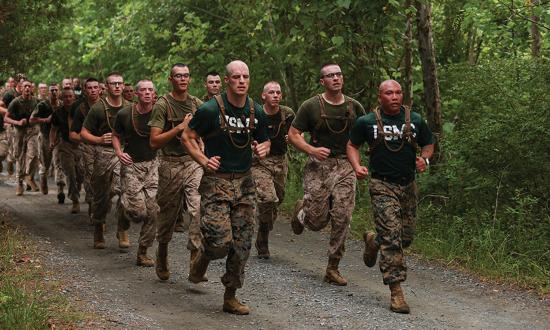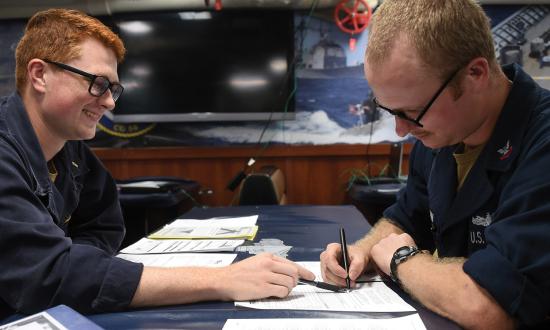In the early 1930s, as commanding officer (CO) of the cruiser USS Augusta (CA-31), then-Captain Chester Nimitz—serving during a time of disarmament and when new fleet construction had been postponed—encouraged leadership, initiative, and ownership in his wardroom by delegating authority to his officers. Delegating authority and facilitating their development led to his crew’s success. Keeping true to those leadership principles throughout the battles in the Pacific during World War II ultimately led to victory over the Japanese fleet, even though U.S. forces initially were severely outnumbered.1
Today, the U.S. Navy finds itself in a similar predicament, facing increasing tensions around the world coupled with technological advances, as well as the ongoing ideological battle between democracy and authoritarianism. Yet, for the past two decades the United States has fought the war on terror, unwittingly paving the way for its peer competitor China to catch up, and, in some ways, move ahead.
The Navy has recently shifted its rudder, refocusing efforts to remain the world’s greatest. The service is investing in its sailors, taking a round turn on ship maintenance, identifying ships that are too old to maintain or too costly to upgrade, and making advances in new technologies such as uncrewed systems and weaponry. Now more than ever, every Navy leader would do well to remember that Admiral Nimitz’s method of leadership still applies: encourage subordinate leadership, provide clear expectations to ensure initiative is possible, and encourage people to own their responsibilities. A leader who exhibits these traits ensures not only the growth of others who will one day be in their shoes, but also that when the time comes, they are ready to do what is needed—to lead.
Foster Initiative
Whether serving as a CO, air boss of a detachment, or department head, every leader must take measure of the trials and tribulations, miscalculations or mistakes made along the way, that “one-way” conversation with their superior that they will never forget, as well as the many successes that got them where they are. Their new challenge is to ensure that those who will one day be in a similar position are trained well and to encourage them to grow from the mistakes they make along the way.
To an aspiring Navy leader, officer or enlisted, the phrase “working your boss out of a job” is well known. Leaders who successfully delegate free space on their own plate, so they are able to focus on more critical needs that demand their experience and expertise. Delegation also opens the door to giving increased responsibilities to subordinates and to further evaluating their abilities and providing critical feedback.
Early in the Pacific war, for example, Admiral Nimitz, gave then–Vice Admiral William “Bull” Halsey a list of targets to strike, but because the environment was continuously changing and the situations were fluid, he allowed Halsey to choose which targets would be optimal.2 If a combatant commander can delegate the decision about which targets to strike during a world war, then delegating tasks such material assessment reports or covering down as the department head should not be hard.
During a fitness report debrief with my CO at the time, a point he shared with me was that he knew I was a stellar second-tour division officer and tactical fire control officer, but he had not been able to assess me beyond that. He wanted to see me taking on a larger role in the department. Afterward, I went back and discussed it with my department head.
Not long after, I was asked to cover down for meetings, take reports, and manage certain department responsibilities. When that happened, I found new motivation and empowerment. I was encouraged to take initiative, keeping my department head updated along the way, so he could focus on being the senior watch officer, managing all the first-tour junior officer qualifications and watch bills for upcoming special evolutions. I was reassured in my value to the team and to the ship, and I found myself on a “relentless pursuit of perfection,” which, at the time, I did not realize was what Admiral Nimitz expected of his officers.3
Set Clear Expectations
To ensure there is an environment in which initiative can be pursued, expectations need to be clear. If you have commander’s intent, you then know what your end state needs to be, and can work out how to get there. Without setting clear expectations, there often will be rework, wasting valuable man hours. How many evolution prebriefs have you sat through that were going horribly wrong, and then afterward you heard the CO or executive officer say “Come see me after this,” or the brief gets rescheduled for a later date so corrections can be made? For those under your charge to produce results, they first must know what you want.
The first brief I ever made as a junior officer was as the electronic warfare officer. I had been on board only a few months when my department head directed me to make a brief outlining the deceptive lighting evolution. With little detail and with no commander’s intent, I failed miserably. Using a previous brief from the shared drive, I turned what could have been a very straightforward brief into something that had several errors. For example, the brief covered the lighting scheme that would be used but neglected to mention any rigging safety considerations. I also failed to ensure the bridge team and tactical action officer who were going to be on watch during the evolution were at the brief.
In the end, I failed to ask the right questions. I did not ask my chief for assistance, consult with the ship’s information warfare officer about what was needed, or submit my brief in advance to my department head. It ended with me having to talk with my department head and then both of us going to talk with the CO about the plan. It is a situation I will never forget, and, from then on, I have always made sure to fully understand the expectations—not only for myself, but also for the team—to prevent a similar experience.
Match Skills
Everyone has their own personalities, interests, strengths, and weaknesses. A strong leader is going to assess the people they are leading and find out what they are good at, while at the same time promoting opportunities for them to grow in areas that need improvement.
During the initial U.S. strikes on the Japanese, Admiral Nimitz was given the plans for an attack against the Marshall Islands. His first choice for the mission was Rear Admiral Wilson Brown’s task force because of Brown’s seniority as a task force commander. But Brown argued that the mission was too dangerous and declined to lead it. Nimitz did not fire Brown because he knew Brown was valuable to the war effort. But he needed someone aggressive and motivated to carry out the mission. Nimitz presented the opportunity to Vice Admiral Halsey, who “jumped at the chance,” stating “he would go anywhere.” Nimitz had found the man with the right skills to execute his mission.4
I experienced this early in my career as the ship’s electrical officer when my CO offered me an opportunity to support the system test officer for an upcoming in-service inspection (InSurv). To allow the InSurv coordinator and system test officer to maintain the big picture, my role was to run point on the engineering tasks by facilitating coordination and execution among topsiders, engineers, and the maintenance community. It was a lot of pressure for a freshly pinned lieutenant (junior grade), but it taught me to stretch my talents for the benefit of the team.
A similar instance occurred during my second tour, when our operations officer was having some difficulties in his position. The officers and chief petty officers in his department had a hard time working for him, causing tension within the department. Rather than detach the operations officer for cause, our CO had him switch roles with the plans and tactics officer. As plans and tactics officer, he had fewer people to manage, which allowed him to work on his people skills and excel in tactics. His analytical skills and ability to recite publications made him a vital asset when it came to doctrine development while deployed. This second chance allowed the lieutenant ultimately to be successful and get back on track.
Cultivate Others’ Success
Giving your people opportunities to grow and succeed is a vital part of being a good leader. After the raids on the Marshalls, Nimitz—who had significant influence on the attacks—ensured Halsey received recognition. When the Department of the Navy released details of the attacks, the credit was given to Halsey, bumping him into the public spotlight.5 To guarantee it has capable officers and sailors prepared for the next battle, the Navy needs leaders to foster initiative among those under their charge, provide clear expectations, and match skills to requirements. By emulating Admiral Nimitz’s leadership style—particularly how he delegated key tasks—today’s Navy leaders will develop officers and sailors who are ready for the demands of tomorrow.
1. Trent Hone, Mastering the Art of Command: Admiral Chester W. Nimitz and Victory in the Pacific (Annapolis: Naval Institute Press, 2022), 4–14.
2. Hone, Mastering the Art of Command, 37–38.
3. Hone, 5.
4. Hone, 34–38.
5. Hone.









